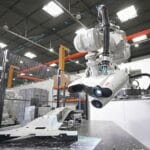~ Fiber alignment in composite materials ~
Animals as different as lions, piranha and ants have something in common: their ability to hunt in groups. The anatomy of a wild hunt is complex. Each member of the pack has a role to play, and a specific position in the group’s formation. Just a step out of line could be the difference between dinner and empty stomachs. When producing composites, placement is also key. Here Lauri Turunen, product business owner at leading manufacturer of pultruded composites Exel Composites, investigates the possibilities of fiber alignment in composite materials.
When looking to invest in composite materials, potential users may assume that the fibers that determine the material’s performance can only be structured in a certain way. This could ring especially true for those who are accustomed to working with isotropic structures, such as those that make up steel and aluminium, where the material has identical properties in all directions, at any given point.
Using materials with isotropic structures can be beneficial. Their unidirectional arrangement means that when a specific load is applied at any point, the material will exhibit the same strength, stress and strain. In many other instances, however, product engineers may not want their materials to possess an entirely uniform structure. In these cases, engineers should unlock the possibilities of composite materials.
Bear the load
When using composites, the way the material’s fibers are aligned impacts the mechanical performance of the structure. Composite manufacturers can place fibers in such a way that the finished product boasts a set of benefits that are bespoke to that application. But before a manufacturer begins designing the composite solution, they must thoroughly analyze its intended uses.
First, the load case of the material’s destined application must be defined. Determining the load case establishes the amount of force the material may be placed under, and which parts of the profile will receive greater or lesser loads.
There are many questions to consider when thinking about the potential load of a composite application: Will the load be axial, or does the product need to transfer some torsional or shear forces? If the product is bent, in which direction does it bend? And what are the expected impacts of the product?
Understanding the load case of the product means that the manufacturer can make sure the position of the material’s fibers reflects its required strength. If the end product will be placed under strain in certain areas, or if the shape of the profile has an impact on its load, then the alignment of the composite’s fibers can account for this.
Alignment methods
Once the main loads are known, laminate layup can be designed in a way that means fibers are directed to suit the composite’s mechanical needs. A laminate refers to the fibrous layers of composite that are joined to form the finished profile.
When considering fiber alignment, it’s important to use what’s needed — and nothing more. Sometimes additional lamination is required to boost mechanical properties. For example, this may involve placing a thinner layer of carbon fiber on the top layer of the laminate instead of a thicker layer of fiberglass. Carbon fiber is often hailed as a more expensive option, particularly when compared to fiberglass, but its high tensile strength and stiffness at a lower weight means that a thinner amount of carbon fiber can be used to keep costs low and maintain a high performance.
Multiaxial, or woven, fabrics offer another alignment method. In these fabrics, the mechanical performance of the reinforcement is enhanced by stitching alternately oriented layers of unidirectional fibers together in such a way that the fibers themselves remain straight and do not ‘stretch’ under load. When forming a multiaxial fabric, producers can be precise with the fiber alignment, which can be placed in many different orientations, to give the material its strength and stiffness properties exactly where they are required.
Other alignment structures may use pull-winding, a continuous composite manufacturing technique during which fibers are aligned helically in a spiral formation around the profile to create a mix of multiaxial and helical fibers. The advantage of the pull-winding method is in the fiber alignment possibilities of both the crosswise and longitudinal directions that enable a wider range of solutions, and even thinner profile walls, such as those used for tubing.
In the mix
Hybrid composites may also help product engineers make the most out of several types of fiber. Carbon fiber and fiberglass are commonly used in hybrid composites, although it is possible to produce a hybrid using a variety of other fibers — such as natural ones. By using a hybrid structure, the optimum ratio of both materials’ mechanical properties can be reached to cater for the needs of an individual application.
Economic value is an obvious benefit of the hybrid technique. Composites often have a reputation for their steep price, but the ability to mix more expensive carbon fibers with cheaper alternatives means that the fiber’s benefits can still be harnessed at a more friendly price point. What’s more, fibers like carbon fiber are strong, but inherently more brittle. By combining the fibers with a more flexible option, producers can improve the rigidity of the material and increase its impact resistance.
Using continuous manufacturing techniques, Exel can produce a range of composite tubes with fibers that meet the exact requirements of the customer. Our hybrid tubes are manufactured using the same pultrusion and pull-winding processes and we work with you to recommend and design the optimal solution for your needs, even if it means selling a less expensive product. Customers are often drawn in by reputation of carbon fiber, others are simply unaware of the fiber flexibility of composite materials. Assessing the customer’s needs is a key part of the process, especially as the structural possibilities of composites are so much more diverse than isotropic alternatives.
A deviation from formation in the animal kingdom may result in hunting disaster. Placement is also important in materials technology, although composites allow for far greater flexibility. By using composites instead of metals, product engineers can benefit from the many possibilities of fiber placement and create a solution that is cost effective, durable and bespoke to their needs.








